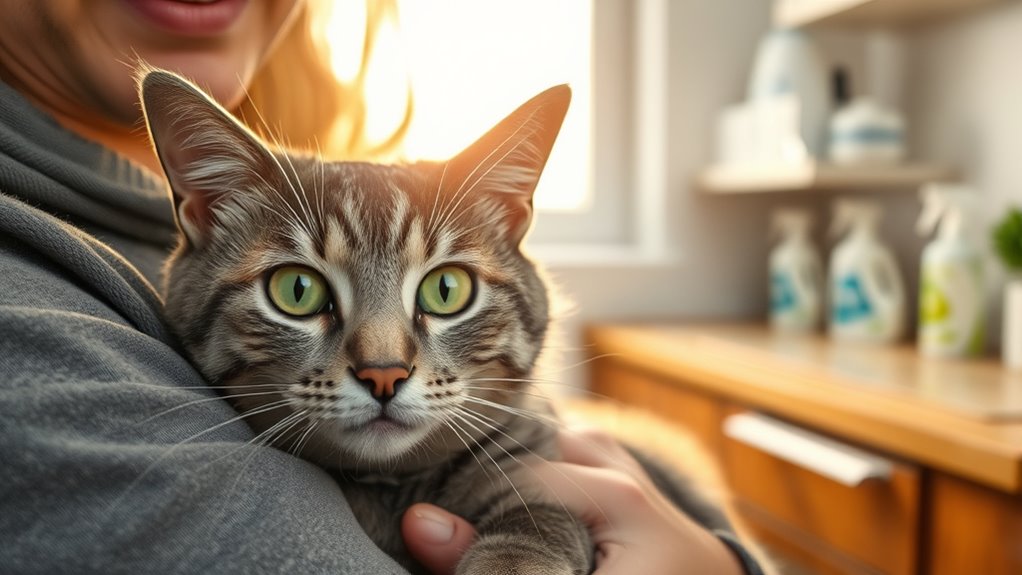As a cat owner, your risk of toxoplasmosis mainly comes from handling cat litter contaminated with infectious oocysts, which become infectious within 1-5 days. To protect yourself, always wear gloves, wash your hands thoroughly afterward, and avoid scooping litter if pregnant or immunocompromised. Keeping cats indoors, feeding them cooked food, and maintaining good hygiene are key. Following these precautions can substantially reduce your risk—discover more tips to keep both you and your cat safe.
Key Takeaways
- Proper litter handling, including wearing gloves and frequent cleaning, significantly reduces toxoplasmosis infection risk.
- Most healthy individuals experience mild or no symptoms; immunocompromised persons should take extra precautions.
- Keep cats indoors and avoid feeding raw meat to prevent infection and environmental contamination.
- Disinfect litter boxes with hot water and soap regularly to eliminate *Toxoplasma gondii* oocysts.
- Understanding the parasite’s life cycle aids in implementing effective hygiene and preventive measures.

Toxoplasmosis is a parasitic infection that poses a significant health risk, especially for pregnant women and individuals with weakened immune systems. If you’re a cat owner, you should be aware of how your interactions with your pet, particularly handling cat litter, can influence your risk. The parasite responsible for toxoplasmosis, Toxoplasma gondii, often finds its way into your environment through contaminated cat feces. Cats usually acquire the parasite by hunting or eating infected prey, and then they shed the infectious oocysts in their litter box. These oocysts become infectious within one to five days, making it crucial to manage and clean the litter box properly.
Your immune system plays a vital role in controlling the infection if exposure occurs. For most healthy individuals, the immune system can contain the parasite, preventing illness or limiting symptoms to mild flu-like signs. However, if your immune defenses are compromised—due to conditions like HIV/AIDS, cancer treatments, or immunosuppressive medications—the parasite can reactivate or cause more severe illness. That’s why handling cat litter with care is so important; improper cleaning can increase your chances of accidental ingestion of infectious oocysts.
A strong immune system helps prevent severe toxoplasmosis but proper litter handling remains essential.
When you change cat litter, always wear gloves and wash your hands thoroughly afterward. Avoid scooping litter if you’re pregnant or immunocompromised, as even small amounts of contact can pose risks. It’s best to let someone else handle the task or switch to a litter box with a hood or cover, which helps contain the oocysts and reduces the chance of spread. Cleaning the litter box daily is essential since oocysts need at least 24 hours to become infectious. Using hot water and soap to disinfect the box regularly can significantly cut down on the parasite’s presence. Additionally, proper hygiene practices play a crucial role in minimizing infection risk. Proper sanitation and understanding of parasite life cycle are key components in reducing transmission.
Maintaining good hygiene with your cat and environment also helps lower the risk. Keep your cat indoors to prevent hunting infected prey, and feed it commercial, cooked, or dried food instead of raw meat, which can carry the parasite. Regular veterinary checkups and testing can identify if your cat is infected, so you can take appropriate precautions. Remember, your immune system is your first line of defense, but it’s not foolproof. By being vigilant about handling cat litter and practicing good hygiene, you reduce your chances of infection and protect yourself and your developing baby if you’re pregnant. Staying informed and cautious ensures you can enjoy your feline companionship without unnecessary health risks. Proper sanitation and understanding the life cycle of Toxoplasma gondii can further help in reducing the risk of infection. Additionally, being aware of the environmental contamination risks can aid in overall prevention strategies. Regular education about infection transmission routes can empower you to make safer choices for your health.
Frequently Asked Questions
Can I Get Toxoplasmosis From Handling Cat Litter Without Gloves?
Handling cat litter without gloves can expose you to toxoplasmosis if you don’t practice good hand hygiene. Toxoplasma gondii, the parasite behind the disease, can be present in contaminated litter. To stay safe, always wear gloves when cleaning the litter box and wash your hands thoroughly afterward. Proper litter disposal is vital—dispose of used litter in sealed bags and wash your hands immediately to minimize infection risk.
Are Outdoor Cats More Likely to Carry Toxoplasmosis Than Indoor Cats?
Imagine outdoor cats as wandering adventurers, exploring the world and gathering stories—some of which include carrying toxoplasmosis. They face higher outdoor risks, increasing their chances of becoming carriers. The prevalence of toxoplasmosis is generally greater among outdoor cats, as they’re exposed to contaminated soil and prey. So, if you’re concerned about risks, keep your indoor cat safe and limit outdoor adventures to reduce potential exposure.
How Long Does It Take to Develop Immunity After Exposure?
After exposure, your immune response starts within a few days, but it typically takes 1 to 3 weeks for immunity to develop fully. The incubation period for toxoplasmosis varies, usually lasting from 5 to 23 days, depending on your immune system. During this time, your body works to recognize and fight the parasite, so early exposure can lead to quicker immunity if your immune response is strong.
Can Toxoplasmosis Be Transmitted Through Cat Scratches?
You might wonder if toxoplasmosis can spread through cat scratch transmission. While it’s rare, scratches contaminated with infected cat feces or saliva could theoretically transmit the parasite. However, most often, toxoplasmosis symptoms result from ingestion of contaminated food or water rather than scratches. To stay safe, clean any scratches thoroughly and avoid contact with cat feces. Always consult your vet if you notice any symptoms or concerns.
Are Certain Cat Breeds More Prone to Carry Toxoplasmosis?
You might wonder if certain cat breeds are more prone to carry toxoplasmosis. Breed susceptibility and genetic predisposition play roles, but any cat can harbor the parasite, especially if exposed to contaminated soil or raw meat. While some breeds may have a slightly higher risk, it is crucial to practice good hygiene, like washing hands after handling your cat or cleaning litter, to minimize your chances of infection regardless of breed.
Conclusion
Think of toxoplasmosis risk as a delicate garden—you hold the keys to its safety. With careful steps like proper hygiene and regular vet visits, you become the gardener who nurtures without harm. Your actions are the gentle rain and sunshine, guiding your feline friends and your family toward a healthy, flourishing life. By staying informed and vigilant, you protect this precious garden, ensuring it blooms with love and wellness for all who dwell within.









